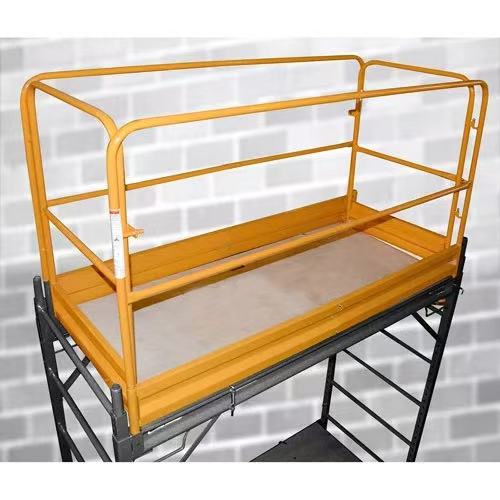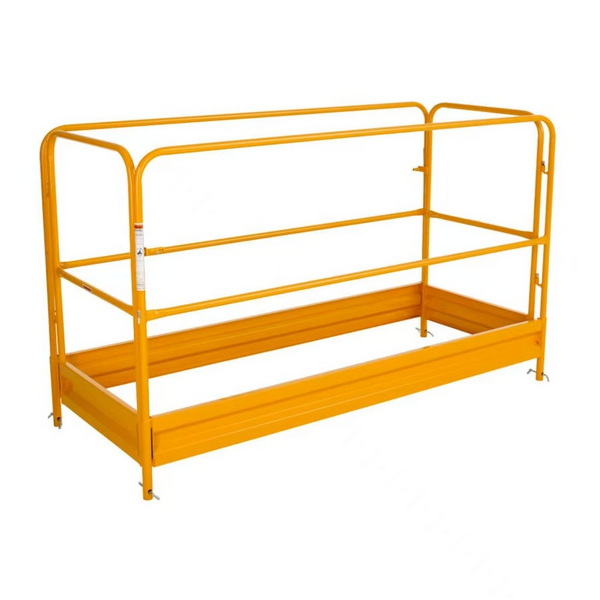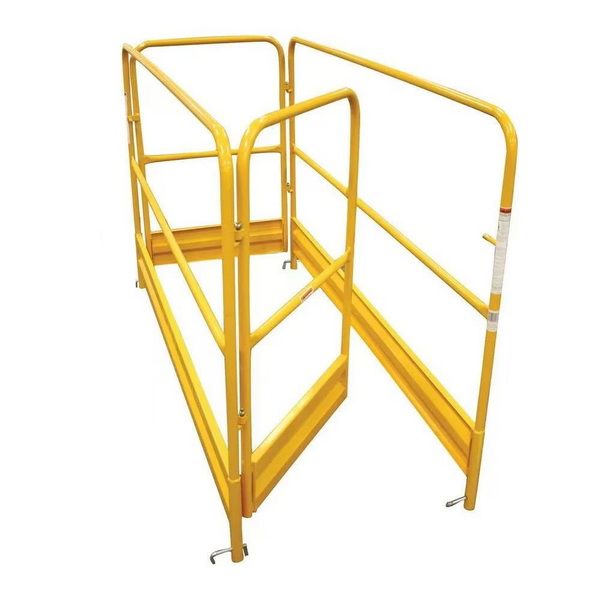Content Menu
● The Importance of Scaffolding Guard Rail Systems
● Key Benefits
● Regulatory Standards for Scaffolding Guard Rail Systems
>> OSHA Requirements
>> State and Local Regulations
● Components of a Scaffolding Guard Rail System
>> Top Rail
>> Mid-Rail
>> Toeboard
>> Support Structures
● Types of Scaffolding Guard Rail Systems
>> Standard Guard Rail Systems
>> Adjustable Guard Rail Systems
>> Specialized Guard Rail Systems
● Installation and Maintenance of Scaffolding Guard Rail Systems
>> Installation Guidelines
>> Maintenance Practices
● Common Scaffolding Hazards and How Guard Rails Mitigate Them
>> Falls from Height
>> Falling Objects
>> Structural Instability
>> Electrocution
● Case Studies: Real-World Examples of Guard Rail Effectiveness
>> Case Study 1: Construction Site Fall Prevention
>> Case Study 2: Maintenance Project Safety
● Advanced Safety Measures and Technologies
>> Smart Guard Rails
>> Automated Installation Systems
>> Enhanced Material Design
>> Integration with Personal Protective Equipment (PPE)
● Best Practices for Implementing Scaffolding Guard Rail Systems
>> Comprehensive Risk Assessment
>> Thorough Worker Training
>> Regular Safety Audits
>> Encouraging a Safety-First Culture
>> Continuous Improvement
● The Economic Benefits of Investing in Scaffolding Guard Rail Systems
>> Reduced Workers' Compensation Costs
>> Increased Productivity
>> Improved Project Timelines
>> Enhanced Reputation
● Future Trends in Scaffolding Safety
>> Wearable Technology
>> Virtual Reality (VR) Training
>> Drone Inspections
● Conclusion
● FAQ
>> 1. What are the primary components of a scaffolding guard rail system?
>> 2. How high must a scaffold be before guard rails are required by OSHA?
>> 3. What force should a scaffolding guard rail system be able to withstand?
>> 4. What are some common hazards associated with scaffolding work, and how do guard rails help mitigate them?
>> 5. How often should scaffolding guard rail systems be inspected?
● Citations:
Scaffolding is indispensable in construction, maintenance, and various other industries, providing elevated platforms for workers to perform tasks safely and efficiently. A scaffolding guard rail system is a critical component, designed to prevent falls and ensure worker safety on these elevated platforms. Understanding and adhering to safety standards for scaffolding guard rail systems is paramount to minimizing risks and creating a secure working environment. This article delves into the safety standards, design considerations, benefits, and practical applications of scaffolding guard rail systems, providing a comprehensive guide for industry professionals and safety managers.

The Importance of Scaffolding Guard Rail Systems
Falls are a leading cause of injuries and fatalities in the construction industry. According to OSHA, implementing effective fall protection measures, such as scaffolding guard rail systems, can significantly reduce these incidents. A scaffolding guard rail system acts as a physical barrier, preventing workers from accidentally slipping or falling from elevated platforms.
Key Benefits
- Fall Prevention: The primary benefit of a scaffolding guard rail system is to prevent falls, protecting workers from serious injuries or fatalities.
- Delineation of Work Zones: Guard rails clearly mark work areas, enhancing awareness and encouraging adherence to safety protocols.
- Prevention of Unauthorized Access: The visibility of guard rails deters unauthorized personnel from entering hazardous areas, minimizing risks.
- Enhanced Site Safety: By reducing the risk of accidents, guard rails contribute to a safer overall work environment.
- Promoting a Safety Culture: Demonstrating a commitment to worker safety through the use of guard rails fosters a sense of responsibility and care among the team.
Regulatory Standards for Scaffolding Guard Rail Systems
Several regulatory bodies, including OSHA in the United States, set standards for scaffolding guard rail systems. These standards outline specific requirements for the design, construction, and use of guard rails to ensure maximum safety.
OSHA Requirements
OSHA standards for scaffolding, detailed in 29 CFR 1926 Subpart L, provide comprehensive guidelines for ensuring scaffold safety. Key requirements include:
- Height Requirements: On supported scaffolds, OSHA typically requires guardrail installation at heights exceeding 10 feet.
- Guardrail Dimensions: Guardrails must be installed between 38 and 45 inches (0.9 to 1.1 meters) high, with midrails placed approximately halfway between the platform and the top rail.
- Strength Requirements: Guardrail systems must withstand a force of at least 200 pounds (890 N) at any point along the top rail, applied downward or outward. Midrails must withstand a force of at least 150 pounds (667 N).
- Toeboards: Toeboards, at least 3.5 inches (89 mm) high, are required to prevent tools and materials from falling off the platform.
- Surface Conditions: Guardrails are not permitted on surfaces with a pitch exceeding 6 in 12.
State and Local Regulations
In addition to federal regulations, state and local governments may introduce further laws to enhance safety protocols. Employers must stay informed about these evolving regulatory updates to ensure compliance.
Components of a Scaffolding Guard Rail System
A standard scaffolding guard rail system comprises several key components, each serving a specific purpose in ensuring safety.
Top Rail
The top rail is the primary barrier, designed to prevent workers from falling off the platform. It must be at least 0.9 meters but not more than 1.1 meters above the platform surface. The top rail must be capable of withstanding a force of at least 200 pounds (890 N).
Mid-Rail
The mid-rail is positioned about halfway between the platform and the top rail, providing an additional barrier to prevent falls. It must be capable of withstanding a force of at least 150 pounds (667 N).
Toeboard
The toeboard is a vertical barrier installed at the platform level to prevent tools, materials, and debris from falling off the scaffold. It should be at least 89 mm (approximately 9 cm) high if made from wood.
Support Structures
Support structures, such as posts and frames, provide stability and strength to the guardrail system. These components must be properly installed and made from durable materials like steel or aluminum.
Types of Scaffolding Guard Rail Systems
Various types of scaffolding guard rail systems are available, each designed to suit different scaffolding types and work conditions.
Standard Guard Rail Systems
These systems consist of top rails, mid-rails, and toeboards, providing a basic level of fall protection. They are suitable for a wide range of scaffolding applications.
Adjustable Guard Rail Systems
Adjustable guard rail systems allow for height adjustments, accommodating different working heights and scaffold configurations. These are particularly useful for tasks requiring flexibility.
Specialized Guard Rail Systems
Specialized guard rail systems are designed for specific scaffolding types or unique work environments. Examples include:
- Mesh Guard Rails: These systems incorporate a mesh screen between the top rail and mid-rail, providing additional protection against falling debris.
- Netting Systems: Netting systems use netting to create a barrier, offering a flexible and lightweight fall protection solution.

Installation and Maintenance of Scaffolding Guard Rail Systems
Proper installation and regular maintenance are crucial for the effectiveness of scaffolding guard rail systems.
Installation Guidelines
- Pre-Installation Inspection: Before installation, inspect all components for damage or defects.
- Proper Assembly: Ensure all components are correctly assembled and installed in the correct sequence.
- Secure Connections: Verify that all connections are secure and stable.
- Compliance with Regulations: Ensure the installed guardrail system meets all relevant regulatory requirements.
Maintenance Practices
- Regular Inspections: Conduct regular inspections to identify any signs of damage, wear, or corrosion.
- Prompt Repairs: Address any identified issues immediately to maintain the guardrail system's integrity.
- Component Replacement: Replace damaged or worn components with manufacturer-approved replacements.
- Documentation: Keep records of all inspections, maintenance, and repairs.
Common Scaffolding Hazards and How Guard Rails Mitigate Them
Scaffolding work presents several potential hazards that can be mitigated by using properly installed and maintained guard rails.
Falls from Height
Falls are the most common scaffolding hazard. Guard rails provide a physical barrier that prevents workers from accidentally stepping off the platform or losing their balance.
Falling Objects
Tools, materials, and debris falling from scaffolds can injure workers below. Toeboards, in combination with mesh screens, prevent objects from falling off the platform.
Structural Instability
Scaffolding can become unstable due to improper assembly, overloading, or environmental factors. Regular inspections and adherence to load limits help maintain structural integrity.
Electrocution
Contact with electrical sources is a significant risk when working on scaffolds near power lines. Maintaining safe distances from power lines and using insulated tools can prevent electrocution.
Case Studies: Real-World Examples of Guard Rail Effectiveness
Several case studies demonstrate the effectiveness of scaffolding guard rail systems in preventing accidents and injuries.
Case Study 1: Construction Site Fall Prevention
A construction company implemented a comprehensive fall protection program that included the use of scaffolding guard rail systems on all elevated platforms. Over a three-year period, the company reported a 40% reduction in fall-related incidents.
Case Study 2: Maintenance Project Safety
During a bridge maintenance project, workers used adjustable scaffolding guard rail systems to perform repairs at varying heights. The guard rails prevented several potential falls, ensuring the project was completed without any serious injuries.
Advanced Safety Measures and Technologies
Beyond the basic components and standards, advanced safety measures and technologies are continuously being developed to enhance the effectiveness of scaffolding guard rail systems.
Smart Guard Rails
Smart guard rails incorporate sensors and monitoring systems to detect potential hazards, such as excessive loads, unstable conditions, or unauthorized access. These systems can provide real-time alerts, enabling immediate corrective actions.
Automated Installation Systems
Automated installation systems use robotic technology to install and dismantle guard rails quickly and safely. These systems reduce the risk of human error and improve overall efficiency.
Enhanced Material Design
Ongoing research focuses on developing stronger, lighter, and more durable materials for guard rail components. Advanced composites and alloys offer improved resistance to impact, corrosion, and environmental factors.
Integration with Personal Protective Equipment (PPE)
Scaffolding guard rail systems are most effective when used in conjunction with personal protective equipment (PPE), such as safety harnesses and lanyards. PPE provides an additional layer of protection, particularly in situations where guard rails alone may not be sufficient.
Best Practices for Implementing Scaffolding Guard Rail Systems
Implementing effective scaffolding guard rail systems requires a comprehensive approach that includes planning, training, and ongoing monitoring.
Comprehensive Risk Assessment
Before beginning any scaffolding work, conduct a thorough risk assessment to identify potential hazards and determine the appropriate type of guard rail system. Consider factors such as working height, environmental conditions, and the nature of the task.
Thorough Worker Training
Provide comprehensive training to all workers on the proper use, installation, and maintenance of scaffolding guard rail systems. Training should cover regulatory requirements, best practices, and the importance of fall protection.
Regular Safety Audits
Conduct regular safety audits to ensure that scaffolding guard rail systems are properly installed, maintained, and used. Identify any areas for improvement and implement corrective actions promptly.
Encouraging a Safety-First Culture
Promote a safety-first culture that emphasizes the importance of fall protection and encourages workers to report any potential hazards. A proactive approach to safety can help prevent accidents and injuries.
Continuous Improvement
Continuously evaluate and improve your fall protection program based on feedback from workers, safety audits, and industry best practices. Stay informed about new technologies and techniques that can enhance the effectiveness of scaffolding guard rail systems.
The Economic Benefits of Investing in Scaffolding Guard Rail Systems
Investing in high-quality scaffolding guard rail systems and comprehensive fall protection programs not only protects workers but also offers significant economic benefits.
Reduced Workers' Compensation Costs
By preventing falls and injuries, scaffolding guard rail systems can help reduce workers' compensation costs. Fewer accidents mean fewer claims, lower insurance premiums, and reduced administrative expenses.
Increased Productivity
A safer working environment can boost worker morale and productivity. When workers feel safe, they are more likely to focus on their tasks and perform their jobs efficiently.
Improved Project Timelines
Accidents can cause significant delays in project timelines. By preventing accidents, scaffolding guard rail systems help ensure that projects are completed on time and within budget.
Enhanced Reputation
Companies that prioritize worker safety are more likely to attract and retain skilled employees. A strong safety record can also enhance a company's reputation and improve its ability to win new contracts.
Future Trends in Scaffolding Safety
The field of scaffolding safety is constantly evolving, with new technologies and techniques being developed to improve worker protection.
Wearable Technology
Wearable technology, such as smart helmets and sensor-equipped vests, can monitor workers' movements, detect potential hazards, and provide real-time alerts.
Virtual Reality (VR) Training
Virtual reality (VR) training can simulate scaffolding environments and provide workers with realistic training experiences. VR training can help workers develop the skills and knowledge needed to work safely on scaffolds.
Drone Inspections
Drones equipped with high-resolution cameras can be used to inspect scaffolding structures and identify potential hazards. Drone inspections can be performed quickly and safely, without the need for workers to climb onto the scaffold.
Conclusion
Scaffolding guard rail systems are essential for ensuring worker safety on elevated platforms. Adhering to regulatory standards, using high-quality components, and implementing proper installation and maintenance practices are critical for maximizing the effectiveness of these systems. By investing in robust scaffolding guard rail systems and promoting a culture of safety, construction companies and other organizations can significantly reduce the risk of accidents and create a safer working environment. The integration of advanced technologies, comprehensive training programs, and a proactive approach to risk management will further enhance the safety and efficiency of scaffolding operations.

FAQ
1. What are the primary components of a scaffolding guard rail system?
The primary components include a top rail (0.9-1.1 meters high), a mid-rail (positioned halfway between the platform and top rail), and a toeboard (at least 89 mm high). These components work together to prevent falls and protect workers from falling objects.
2. How high must a scaffold be before guard rails are required by OSHA?
OSHA typically requires guardrail installation on supported scaffolds at heights over 10 feet (approximately 3 meters). This height requirement ensures that workers are protected from potential falls when working at significant elevations.
3. What force should a scaffolding guard rail system be able to withstand?
Guardrail systems must be capable of withstanding a force of at least 200 pounds (890 N) at any point along the top rail. Midrails must withstand a force of at least 150 pounds (667 N).
4. What are some common hazards associated with scaffolding work, and how do guard rails help mitigate them?
Common hazards include falls from height, falling objects, structural instability, and electrocution. Guard rails mitigate falls by providing a physical barrier, while toeboards and mesh screens prevent objects from falling.
5. How often should scaffolding guard rail systems be inspected?
Scaffolding guard rail systems should be inspected regularly for any signs of damage, wear, or corrosion. Prompt repairs and component replacements should be performed to maintain the system's integrity.
Citations:
[1] https://ehs.utoronto.ca/wp-content/uploads/2015/10/Scaffolds.pdf
[2] https://www.youtube.com/watch?v=uY2vI0_b6hQ
[3] https://www.scaffoldingsolutions.com/articles/recent-scaffolding-safety-guidelines/
[4] https://www.worksafenb.ca/policy-and-legal/legal/interpretations/scaffolding-as-guardrails-acceptable-for-fall-protection
[5] https://www.youtube.com/watch?v=kpZ3-iCs8xA
[6] https://www.labour.gov.hk/eng/public/os/B/mss.pdf
[7] https://www.fallprotect.com/blog/techtalk/osha-requirements-for-guardrail-and-safety-railing-compliance
[8] https://www.youtube.com/watch?v=ThI3pEJcU_4
[9] https://www.osha.gov/training/library/scaffolds/summary
[10] https://www.ihsa.ca/rtf/health_safety_manual/pdfs/equipment/Scaffolds.pdf
[11] https://www.buffalocorpstore.com/product/scaffolding-guard-rail-system/?v=675884b5bee6






















